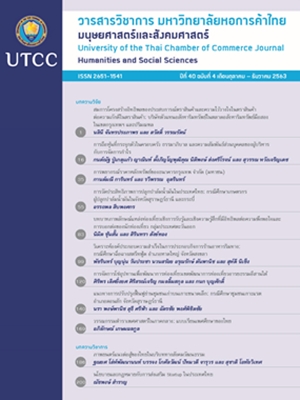Efficiency Measurement of Oil Palm Plantation in Thailand: A Case Study of Oil Palm Agriculturists in Suratthani and Krabi Provinces
Main Article Content
Abstract
The objectives of this study include (1) assessing the efficiency of Oil Palm Agriculturists in Krabi and Suratthani provinces and (2) Identifying factors and estimating impact of these variables on the efficiency score. The researcher applied SBM DEA model under input – oriented approach to evaluate technical efficiency scores, values of input slacks and output slacks together with the decomposition of these scores. Besides, the Tobit regression model was applied to assess the influence of independent variables on the technical efficiency score computed by the aforementioned SBM DEA model.The result showed that the average technical efficiency score for all Oil Palm Agriculturists in the sample was approximately 0.52267. In addition, only 50 Oil Palm Agriculturists operated on the efficiency frontier line. Out of this number, 28 were agriculturists in Krabi province and the rest of 22 were agriculturists in Suratthani province. The computation of output and input slacks and their decomposition suggested that Agriculturists with inefficient operation should reduce the farm size, expenses on fertilizer, and expenses on harvesting process, respectively. For the impact analysis by using the Tobit regression model, the factors significantly affecting technical efficiency score included total revenue from selling Oil Palm, dummy variable representing agriculturist with RSPO standard, total expenses on oil palm production, and amount of output per Rai.
Article Details
ลิขสิทธิ์ของบทความ
ผลงานที่ได้รับการตีพิมพ์ถือเป็นลิขสิทธิ์ของมหาวิทยาลัยหอการค้าไทย ห้ามมิให้นำเนื้อหา ทัศนะ หรือข้อคิดเห็นใด ๆ ของผลงานไปทำซ้ำ ดัดแปลง หรือเผยแพร่ ไม่ว่าทั้งหมดหรือบางส่วนโดยไม่ได้รับอนุญาตเป็นลายลักษณ์อักษรจากมหาวิทยาลัยหอการค้าไทยก่อน
References
กรมการค้าภายใน. (2562). ปาล์มน้ำมัน ราคาปาล์มน้ำมันและน้ำมันปาล์มรายเดือน. สืบค้นเมื่อ 16 มีนาคม 2563, จาก https://agri.dit.go.th/index.php/department_doc/3/ปาล์มน้ำมัน%20ราคาปาล์มน้ำมันและน้ำมันปาล์มรายเดือน/29
ประพิณวดี ศิริศุภลักษณ์, บุญจิต ฐิตาภิวัฒนกุล, อภิวันท์ กำลังเอก, อิสริยา บุญญะศิริ, รวิสสาข์ สุชาโต, และภาสกร ธรรมโชติ. (2559). รายงานวิจัยฉบับสมบูรณ์โครงการการศึกษาความเป็นไปได้ในการจัดการความเสี่ยงของอุตสาหกรรมปาล์มน้ำมัน (ระยะที่ 2). กรุงเทพฯ: มหาวิทยาลัยเกษตรศาสตร์, คณะเศรษฐศาสตร์, ภาควิชาเศรษฐศาสตร์เกษตรและทรัพยากร.
วิรัช กระแสร์ฉัตร์. (2546). การศึกษาศักยภาพการผลิต และการตลาดปาล์มน้ำมัน. กรุงเทพฯ: สถาบันเทคโนโลยีพระจอมเกล้าเจ้าคุณทหารลาดกระบัง.
สรพงศ์ เบญจศรี, และปัญญา ใจสมุทร (2557). รายงานวิจัยฉบับสมบูรณ์โครงการประสิทธิภาพการผลิตปาล์มน้ำมันอย่างยั่งยืนตามมาตรฐาน Roundtable on Sustainable Palm Oil ของเกษตรกรในประเทศไทย. พัทลุง: มหาวิทยาลัยทักษิณ, คณะเทคโนโลยีและการพัฒนาชุมชน, สาขาวิชาพืชศาสตร์.
สำนักงานเศรษฐกิจการเกษตร. (2562). ปาล์มน้ำมัน: เนื้อที่ยืนต้น เนื้อที่ให้ผล ผลผลิต และผลผลิตต่อไร่ ปี 2561 ระดับจังหวัด. สืบค้นเมื่อ 16 มีนาคม 2563, จาก http://www.oae.go.th/view/1/ปาล์มน้ำมัน/TH-TH
Banker, R .D, & Morey, R.C. (1986). Efficiency analysis for exogenously fixed inputs and outputs. European Journal of Operational Research, 34(4), 553-565.
Banker, R. D., Charnes, A., & Cooper, W. W. (1984). Some models for the estimation of technical and scale inefficiencies in data envelopment analysis. Management Science, 30(9), 1078-1092.
Charnes, A., Cooper W. W., & Rhodes, E. (1978). Measuring the efficiency of decision making units. European Journal of Operational Research, 2(6), 429-444.
Charnes, A., Cooper, W.W., Golany, B., Seiford, L.M., & Stutz, J. (1985). Foundations of data envelopment analysis and Pareto–Koopmans empirical production functions.Journal of Econometrics, 30(1-2), 91-107.
Cooper, W. W., Seiford, L. M., & Tone, K. (2006). A comprehensive text with models, applications, references and DEA – solver software (2nd ed.). New York, NY: Springer.
Farrell, M. J. (1957). The measurement of productive efficiency. Journal of Royal Statistical Society, 120(3), 253-281
Pang, J., Chen, X., Zhang, Z., & Li, H. (2016). Measuring eco-efficiency of agriculture in China. Sustainability, 8(4), 1-15.
Seiford, L. M., & Zhu, J. (2002). Modeling undesirable factors in efficiency evaluation. European Journal of Operational Research, 142(1), 16-20.
Tobin, J. (1958). Estimation of relationships for limited dependent variables. Econometrica, 26(1), 24-36.
Tone, K. (2001). A slacks-based measure of efficiency in data envelopment analysis. European Journal of Operational Research, 130(3), 498-509.
Zhou, L., & Zhu, S. (2017). Research on the efficiency of Chinese commercial banks based on undesirable output and super-SBM DEA model. Journal of Mathematical Finance, 7(1), 102-120.


